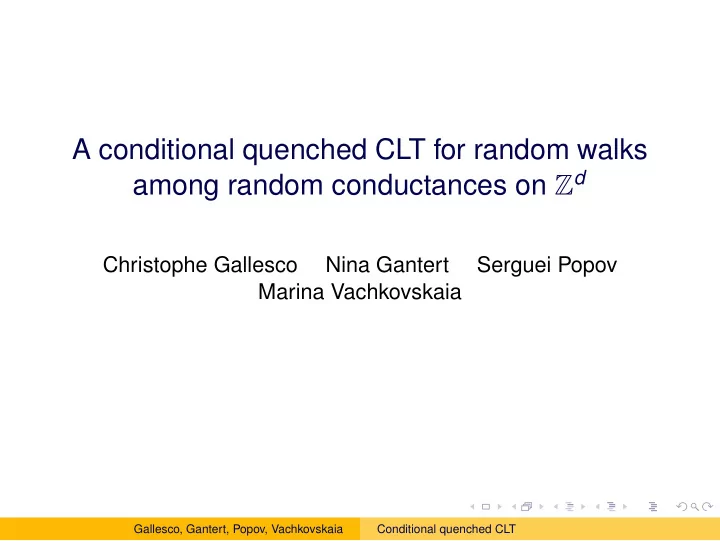

A conditional quenched CLT for random walks among random conductances on Z d Christophe Gallesco Nina Gantert Serguei Popov Marina Vachkovskaia Gallesco, Gantert, Popov, Vachkovskaia Conditional quenched CLT
The model: ◮ In Z d , to any unordered pair of neighbors attach a positive number ω x , y (conductance between x and y ). ◮ P stands for the law of this field of conductances. We assume that P is stationary and ergodic. ◮ Define π x = � y ∼ x ω x , y , and let the transition probabilities be � ω x , y π x , if y ∼ x , q ω ( x , y ) = 0 , otherwise , ◮ P x ω is the quenched law of the random walk starting from x , so that P x P x ω [ X ( 0 ) = x ] = 1 , ω [ X ( k + 1 ) = z | X ( k ) = y ] = q ω ( y , z ) . Gallesco, Gantert, Popov, Vachkovskaia Conditional quenched CLT
(many recent papers) = ⇒ under mild conditions on the law of ω -s, the Quenched Invariance Principle holds: For almost every environment ω , suitably rescaled trajectories of the random walk converge to the Brownian Motion (with nonrandom diffusion constant σ ) in a suitable sense. Main method of the proof: the “corrector approach”, i.e., find a “stationary deformation” of the lattice such that the random walk becomes martingale. The corrector is shown to exist, but usually no explicit formula is known for it. Gallesco, Gantert, Popov, Vachkovskaia Conditional quenched CLT
Brownian Meander: Let W be the Brownian Motion starting from 0, and define τ 1 = sup { s ∈ [ 0 , 1 ] : W ( s ) = 0 } and ∆ 1 = 1 − τ 1 . Then, the Brownian Meander W + is defined in this way: W + ( s ) := ∆ − 1 / 2 | W 1 ( τ 1 + s ∆ 1 ) | , 0 ≤ s ≤ 1 . 1 Informally, the Brownian Meander is the Brownian Motion conditioned on staying positive on the time interval ( 0 , 1 ] . Example: simple random walk S , conditioned on { S 1 > 0 , . . . , S n > 0 } , after usual scaling converges to the Brownian Meander. Gallesco, Gantert, Popov, Vachkovskaia Conditional quenched CLT
Let Λ n := { X 1 ( k ) > 0 for all k = 1 , . . . , n } ( X 1 is the first coordinate of X ). Consider the conditional quenched probability measure Q n ω [ · ] := P ω [ · | Λ n ] . Define the continuous map Z n ( t ) , t ∈ [ 0 , 1 ]) as the natural polygonal interpolation of the map k / n �→ σ − 1 n − 1 / 2 X ( k ) (with σ from the quenched CLT). For each n , the random map Z n induces a probability measure µ n ω on ( C [ 0 , 1 ] , B 1 ) : for any A ∈ B 1 , ω [ Z n ∈ A ] . µ n ω ( A ) := Q n Gallesco, Gantert, Popov, Vachkovskaia Conditional quenched CLT
Condition E . There exists κ > 0 such that, P -a.s., κ < ω 0 , x < κ − 1 for x ∼ 0. Denote by P W + ⊗ P W ( d − 1 ) the product law of Brownian meander and ( d − 1 ) -dimensional standard Brownian motion on the time interval [ 0 , 1 ] . Now, we formulate our main result: Theorem Under Condition E, we have that, P -a.s., µ n ω (after suitable linear transformation) tends weakly to P W + ⊗ P W ( d − 1 ) as n → ∞ (as probability measures on C [ 0 , 1 ] ). Gallesco, Gantert, Popov, Vachkovskaia Conditional quenched CLT
Strategy of the proof: “go avay a little bit from the forbidden area in a controlled way” (we need to control the time and the vertical displacement), and then use unconditional CLT. X ( t ) vertical displacement 0 t =time to go out ε √ n Gallesco, Gantert, Popov, Vachkovskaia Conditional quenched CLT
Open questions: ◮ other types of conditioning; ◮ P ω [Λ n ] ≃ ? (at least prove it is of order n − 1 / 2 ). Gallesco, Gantert, Popov, Vachkovskaia Conditional quenched CLT
Recommend
More recommend